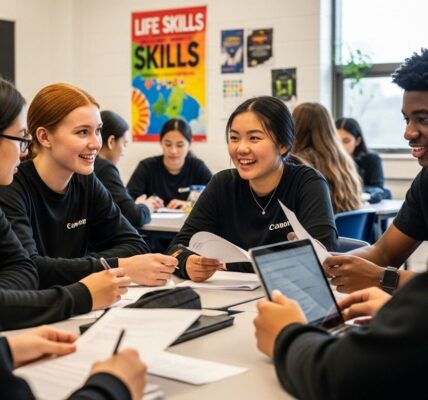
Getting students excited about learning is tougher than ever. Studies show that when students see a real connection between schoolwork and their personal goals, motivation skyrockets. Most people think it takes grand gestures or expensive technology to spark that enthusiasm. Actually, everything changes when teachers simply take time to discover what makes each student tick.
Table of Contents
- Step 1: Identify Student Interests And Needs
- Step 2: Establish Clear Goals And Expectations
- Step 3: Create An Engaging Learning Environment
- Step 4: Implement Interactive Learning Activities
- Step 5: Provide Regular Feedback And Encouragement
Quick Summary
| Key Point | Explanation |
|---|---|
| 1. Identify Student Interests | Understand students’ unique perspectives and motivations to foster engagement. |
| 2. Set Clear Goals | Use SMART criteria to create achievable learning milestones collaboratively with students. |
| 3. Foster an Engaging Environment | Design dynamic spaces that promote student interaction and emotional safety. |
| 4. Implement Interactive Learning | Use hands-on activities to bridge theory and practice, enhancing student participation. |
| 5. Provide Regular Feedback | Offer timely, constructive feedback to build confidence and encourage growth. |
Step 1: Identify Student Interests and Needs
Motivating students begins with understanding their unique perspectives, learning styles, and personal motivations. The foundational step in how to motivate students is creating a connection between their individual interests and the learning process. Successful educators recognize that each student brings a distinct set of experiences, passions, and goals to the classroom.
Understanding Individual Learning Profiles
Effective motivation requires a strategic approach to discovering what genuinely engages each student. Start by conducting comprehensive yet informal assessments that go beyond traditional academic metrics. This means engaging students in conversations about their personal interests, career aspirations, and learning preferences. Consider implementing structured surveys or one on one discussions that allow students to share insights about what excites them academically and personally.
Research from Stanford University’s Educational Psychology Department suggests that students are significantly more motivated when they perceive a direct connection between their learning and personal goals. This approach transforms education from a passive experience to an active, personalized journey.
Practical strategies for identifying student interests include creating interactive first week activities that reveal individual passions. These might involve group discussions, personal reflection exercises, or creative projects that allow students to showcase their unique talents and perspectives. Pay attention to the subtle cues students provide about their learning preferences such as:
- Topics that generate enthusiastic responses
- Learning styles they seem most comfortable with
- External interests that could be integrated into academic work
- Personal challenges or experiences that might influence their motivation
Remember that motivation is not a one size fits all strategy. Each student requires a nuanced approach that respects their individual learning profile. By demonstrating genuine interest in their personal narrative, educators can create a supportive environment that naturally encourages academic engagement and personal growth.

Successful identification of student interests serves as a critical gateway to creating more personalized, meaningful learning experiences. When students feel understood and valued, they are more likely to invest energy into their academic pursuits and develop intrinsic motivation that extends far beyond traditional classroom boundaries.
Step 2: Establish Clear Goals and Expectations
Establishing clear goals and expectations forms the cornerstone of student motivation, transforming abstract learning objectives into tangible, achievable milestones. The process of defining precise academic and personal expectations creates a roadmap that guides students toward meaningful achievement. By articulating explicit goals, educators provide students with a sense of direction, purpose, and understanding of what success looks like in both academic and personal development contexts.
Creating a Structured Goal Setting Framework
Successful goal setting requires a collaborative approach that empowers students to participate actively in defining their academic journey. Begin by designing goals that are specific, measurable, achievable, relevant, and time bound (SMART). This framework helps students translate broad academic expectations into concrete, actionable steps. For instance, instead of presenting a vague objective like “improve math skills,” frame the goal as “increase algebra test scores by 15% within the next semester by completing weekly practice problems and attending tutoring sessions.”
According to National Education Research Center, students who understand and participate in goal setting demonstrate higher levels of intrinsic motivation and academic engagement. Implement goal setting strategies that encourage student ownership and personal investment. This might involve regular goal review sessions where students reflect on their progress, adjust their strategies, and celebrate incremental achievements.
Key elements of effective goal establishment include:
- Collaborative goal creation involving student input
- Transparent communication of academic expectations
- Regular progress tracking and feedback mechanisms
- Flexibility to adjust goals based on individual student development
Expectations should extend beyond academic performance to include behavioral standards, classroom participation, and personal growth objectives. Create a supportive environment where goals are viewed as opportunities for development rather than punitive measures. Develop clear rubrics that outline performance criteria, ensuring students understand the specific behaviors and skills required to meet or exceed expectations.
Verification of successful goal establishment occurs when students can articulate their objectives clearly, demonstrate a proactive approach to achieving them, and show increased self awareness about their learning process.
By transforming goal setting from a top down directive to a collaborative, personalized experience, educators can unlock student potential and foster a culture of continuous improvement and self motivated learning.
Step 3: Create an Engaging Learning Environment
Creating an engaging learning environment transforms traditional educational spaces into dynamic, interactive landscapes where students feel motivated, supported, and inspired to learn. An effective learning environment transcends physical classroom boundaries, encompassing psychological, social, and emotional dimensions that fuel student curiosity and participation.
The physical and emotional atmosphere of a learning space plays a critical role in student motivation. Educators must intentionally design environments that stimulate intellectual curiosity, encourage collaboration, and provide psychological safety. This means moving beyond rigid seating arrangements and traditional lecture formats to create flexible, interactive spaces that adapt to different learning styles and activities.
Physical space transformation involves strategic layout modifications and purposeful design choices. Consider arranging furniture to facilitate group discussions, create collaborative zones, and allow for movement. Incorporate visual elements that inspire learning such as inspirational quotes, student work displays, and interactive learning walls. Color psychology and room layout can significantly impact student engagement and emotional comfort.
According to Stanford University’s Educational Design Research, classroom environments that promote student agency and provide multiple engagement opportunities generate higher motivation levels. Implement strategies that encourage student ownership and participation:
- Create flexible learning zones for different activities
- Incorporate technology that supports interactive learning
- Display student achievements and ongoing project work
- Allow periodic room configuration changes
Beyond physical design, an engaging learning environment requires cultivating a positive classroom culture. This involves establishing clear communication norms, promoting respectful interactions, and creating space for student voice and choice. Encourage collaborative learning experiences where students feel comfortable sharing ideas, asking questions, and supporting one another’s academic growth. Learn more about developing effective study strategies that complement an engaging learning environment.
Verification of a successful engaging environment occurs when students demonstrate increased participation, show enthusiasm for learning activities, and feel emotionally safe to take intellectual risks. By thoughtfully designing learning spaces that are adaptive, inclusive, and student centered, educators can unlock tremendous motivational potential and create transformative educational experiences.
Step 4: Implement Interactive Learning Activities
Interactive learning activities represent a powerful approach to transforming passive educational experiences into dynamic, engaging encounters that capture student attention and stimulate intellectual curiosity. These activities bridge the gap between theoretical knowledge and practical application, creating meaningful learning opportunities that motivate students to actively participate in their educational journey.
Successful interactive learning requires carefully designed experiences that challenge students to think critically, collaborate effectively, and apply knowledge in real world contexts. The goal is to move beyond traditional lecture methods and create opportunities for students to become active participants in their learning process. This might involve simulation exercises, problem solving challenges, group projects, and interactive technology based learning platforms that encourage exploration and discovery.
Designing effective interactive activities demands a nuanced understanding of student interests and learning styles. Consider incorporating diverse approaches that appeal to different cognitive strengths. Role playing scenarios can bring historical or scientific concepts to life, while digital simulations allow students to experiment with complex systems in a risk free environment. Group problem solving tasks encourage communication skills and collaborative thinking, helping students learn from one another while developing critical interpersonal competencies.
According to Harvard University’s Learning Sciences Research, interactive learning activities significantly enhance student motivation by providing immediate feedback and creating opportunities for personal discovery. Practical strategies for implementation include:
- Designing scenario based learning experiences
- Creating collaborative digital platforms
- Developing real world problem solving challenges
- Incorporating game based learning elements
Technology plays a crucial role in expanding interactive learning possibilities. Digital tools like interactive whiteboards, collaborative online platforms, and adaptive learning software can transform traditional classroom interactions. Explore advanced study techniques that complement these interactive approaches and enhance student engagement.
Verification of successful interactive learning occurs when students demonstrate increased enthusiasm, actively participate in discussions, show deeper comprehension of complex concepts, and can apply learned skills in varied contexts. By prioritizing interactive experiences that challenge, inspire, and connect with students personal interests, educators can create powerful motivational environments that transform learning from a passive to an active, exciting journey of discovery.

Step 5: Provide Regular Feedback and Encouragement
Regular feedback and encouragement serve as the critical fuel that transforms student potential into tangible academic achievement. Meaningful feedback creates a supportive framework that helps students understand their progress, recognize their strengths, and strategically address areas needing improvement. This process goes beyond simple grading to become a powerful motivational tool that builds student confidence and self awareness.
Effective feedback requires a delicate balance between constructive critique and genuine encouragement. The goal is to create a supportive dialogue that helps students view challenges as opportunities for growth rather than insurmountable obstacles. Educators must develop communication strategies that highlight individual progress, acknowledge effort, and provide clear, actionable insights for improvement.
The art of providing meaningful feedback involves more than just pointing out errors. It requires a nuanced approach that recognizes individual student journeys, celebrates incremental achievements, and offers specific guidance for future development. This might involve detailed written comments, one on one conversations, or personalized feedback sessions that allow students to reflect on their learning process and set future goals.
According to Stanford University’s Educational Psychology Research, timely and specific feedback significantly impacts student motivation and academic performance. Practical strategies for delivering impactful feedback include:
- Using specific, actionable language
- Balancing constructive critique with positive reinforcement
- Providing timely and consistent feedback
- Offering opportunities for student self reflection
Technology can enhance feedback mechanisms, allowing for more frequent and personalized communication. Digital platforms enable educators to provide real time insights, track student progress, and create more interactive feedback experiences. Discover advanced study techniques that complement effective feedback strategies and support student growth.
Verification of successful feedback implementation occurs when students demonstrate increased self motivation, show improved academic performance, and actively seek opportunities for growth. Students become more engaged, taking ownership of their learning journey and viewing feedback as a valuable tool for personal development rather than a judgmental process.
Below is a checklist table to help educators confirm successful implementation of each motivation strategy mentioned in the article.
| Motivation Strategy | Verification/Completion Criteria |
|---|---|
| Identify Student Interests | Students can articulate interests; classroom activities reflect personalized engagement. |
| Set Clear Goals and Expectations | Students can state their personal and academic goals clearly and track progress. |
| Foster an Engaging Environment | Students participate more, take risks, and express a sense of safety and belonging. |
| Implement Interactive Learning | Students actively contribute, demonstrate understanding, and apply skills practically. |
| Provide Regular Feedback | Students respond positively to feedback, show improvement, and set new goals. |
Unlock Results-Driven Motivation Tools for Your Students
Are you struggling to ignite real excitement and sustained engagement among your students? In the article “How to Motivate Students: Effective Strategies for Success,” you discovered how identifying student interests, creating clear goals, and building active learning environments can overcome common barriers like low motivation and lack of direction. But applying these insights every day can be overwhelming without the right support. Imagine a hub where proven educational strategies and timely insights are always at your fingertips.

Take your next step now by visiting Ultra News. Browse our latest features in the Education section for practical study tips, learning tools, and research-based methods tailored to educators and learners. Explore resources on best study habits for students to reinforce goal-setting, feedback, and interactive activities. Empower your students with expert-backed solutions today and make every lesson count!
Frequently Asked Questions
How can I identify student interests to motivate them?
To identify student interests, educators can conduct informal assessments through conversations, structured surveys, group discussions, and personal reflection exercises that encourage students to share their passions and learning preferences.
What are SMART goals, and how can they help motivate students?
SMART goals are Specific, Measurable, Achievable, Relevant, and Time-bound objectives. They help motivate students by providing clear, actionable steps and a sense of direction, making academic expectations more tangible and attainable.
How can I create an engaging learning environment for my students?
You can create an engaging learning environment by designing flexible classroom spaces that encourage collaboration, incorporating inspiring visual elements, and fostering a positive classroom culture that promotes student voice and choice.
What types of interactive learning activities can motivate students?
Interactive learning activities such as simulation exercises, group projects, problem-solving challenges, and role-playing scenarios can engage students and encourage active participation, making learning more dynamic and relevant.




